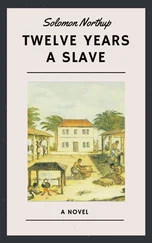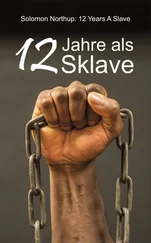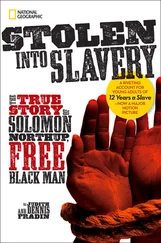As late as 1850 new laws were being passed that made escape from slave states to free states almost impossible. If a black man in a free state was discovered to be a fugitive slave – or, as in the case of Solomon Northup, was simply suspected of being a fugitive slave – any person preventing his return to servitude was liable for a hefty fine. Slaves had no right to trial by jury and were not allowed to testify against whites. Northup came up against this unjust system himself when, even after the great success and widespread publicity of his tell-all memoir, he tried to sue those responsible for selling him into slavery and saw them all acquitted.
12 Years a Slave , published in 1853 – the year of Solomon Northup’s rescue – was not the first exposé written by a former slave. In 1825 fugitive slave William Grimes had published his story in order to raise the money to buy his way out of servitude, while perhaps the most famous slave memoir of them all, Narrative of the Life of Frederick Douglass, an American Slave , had appeared in 1845. But the timing of Northup’s revelations meant that his book became a crucial document for abolitionists in the last decade of American slavery.
One year earlier, in 1852, a white abolitionist author named Harriet Beecher Stowe had published Uncle Tom’s Cabin , a novel that exposed the harsh truth of life as a slave in the Southern states. It became an instant bestseller on both sides of the Atlantic and prompted further debate about slavery – so much so that it is anecdotally credited with instigating the Civil War of 1861–5. Northup’s first-hand account corroborated much of what Beecher Stowe had written in her novel, and was reviewed and written about in major newspapers including the New York Times . Over the next few years, as political divisions between North and South became ever more violent, Northup became a figurehead of the abolitionist movement and travelled around the free states and Canada giving lectures.
Solomon Northup disappeared from the public arena as suddenly as he had been thrust into it; there is little evidence of his whereabouts after 1857. He is not recorded in the census of 1860 and it is unlikely he lived to see the end of slavery in 1865. His memoir might likewise have vanished after it went out of print had historian Sue Eakin not happened upon the book in a bargain store in 1936 and recognised from her childhood a number of the families and plantations Northup mentions. After extensive research by Eakin and others, 12 Years a Slave was reissued in the 1960s and went on to become a bestseller once more. We may never know the end of Solomon Northup’s life story, but there is little doubt that his written legacy inspired his country’s greatest revolution, saving countless other black Americans from the same unspeakable fate.
To Harriet Beecher Stowe:
Whose name, throughout the World, is identified with the Great Reform: This narrative, affording another Key to Uncle Tom’s Cabin, is respectfully dedicated
“It is a singular coincidence, that Solomon Northup was carried to a plantation in the red river country—that same region where the scene of Uncle Tom’s captivity was laid—and his account of the plantation, and the mode of life there, and some incidents which he describes, form a striking parallel to that history.”
— Key to Uncle Tom’s Cabin
Such dupes are men to custom, and so prone
To reverence what is ancient, and can plead
A course of long observance for its use,
That even servitude, the worst of ills,
Because delivered down from sire to son
Is kept and guarded as a sacred thing!
But is it fit, or can it bear the shock
Of rational discussion, that a man
Compounded and made up like other men
Of elements tumultuous, in whom lust
And folly in as ample measure meet
As in the bosom of the slave he rules,
Should be a despot absolute, and boast
Himself the only freeman of his land?
—Cowper
CONTENTS
Cover
Title Page
Copyright
History of Collins
Life & Times
Dedication
Epigraph
Editor’s Preface
Chapter 1
Chapter 2
Chapter 3
Chapter 4
Chapter 5
Chapter 6
Chapter 7
Chapter 8
Chapter 9
Chapter 10
Chapter 11
Chapter 12
Chapter 13
Chapter 14
Chapter 15
Chapter 16
Chapter 17
Chapter 18
Chapter 19
Chapter 20
Chapter 21
Chapter 22
Appendix A
Appendix B
Appendix C
Classic Literature: Words and Phrases
About the Publisher
When the editor commenced the preparation of the following narrative, he did not suppose it would reach the size of this volume. In order, however, to present all the facts which have been communicated to him, it has seemed necessary to extend it to its present length.
Many of the statements contained in the following pages are corroborated by abundant evidence—others rest entirely upon Solomon’s assertion. That he has adhered strictly to the truth, the editor, at least, who has had an opportunity of detecting any contradiction or discrepancy in his statements, is well satisfied. He has invariably repeated the same story without deviating in the slightest particular, and has also carefully perused the manuscript, dictating an alteration wherever the most trivial inaccuracy has appeared.
It was Solomon’s fortune, during his captivity, to be owned by several masters. The treatment he received while at the ‘Pine Woods’ shows that among slaveholders there are men of humanity as well as of cruelty. Some of them are spoken of with emotions of gratitude—others in a spirit of bitterness. It is believed that the following account of his experience on Bayou Boeuf presents a correct picture of slavery, in all its lights and shadows, as it now exists in that locality. Unbiased, as he conceives, by any prepossessions or prejudices, the only object of the editor has been to give a faithful history of Solomon Northup’s life, as he received it from his lips.
In the accomplishment of that object, he trusts he has succeeded, notwithstanding the numerous faults of style and expression it may be found to contain.
David Wilson, Whitehall, New York, May 1853
Having been born a freeman, and for more than thirty years enjoyed the blessings of liberty in a free state—and having at the end of that time been kidnapped and sold into slavery, where I remained, until happily rescued in the month of January, 1853, after a bondage of twelve years—it has been suggested that an account of my life and fortunes would not be uninteresting to the public.
Since my return to liberty, I have not failed to perceive the increasing interest throughout the northern states, in regard to the subject of slavery. Works of fiction, professing to portray its features in their more pleasing as well as more repugnant aspects, have been circulated to an extent unprecedented, and, as I understand, have created a fruitful topic of comment and discussion.
I can speak of slavery only so far as it came under my own observation—only so far as I have known and experienced it in my own person. My object is, to give a candid and truthful statement of facts: to repeat the story of my life, without exaggeration, leaving it for others to determine, whether even the pages of fiction present a picture of more cruel wrong or a severer bondage.
Читать дальше












